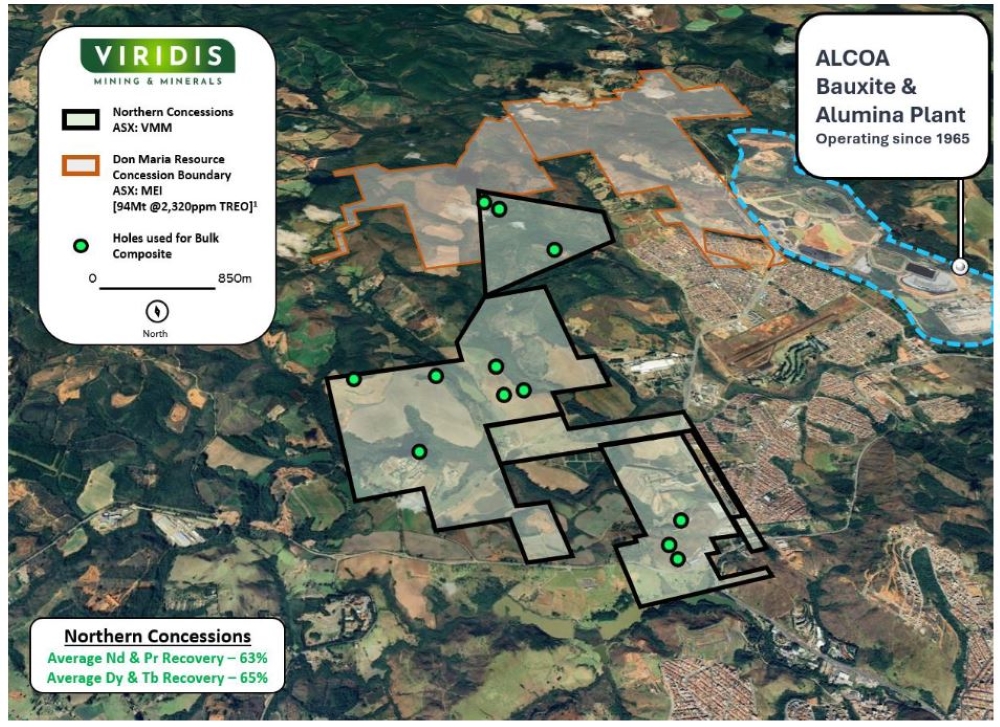Colossus metallurgy outperforms every known ionic rare earth project in the world

Ionic recoveries of up to 80% have been shown at Colossus. Pic via Getty Images.
- Tests from Viridis’s Northern Concenssions show head grades of 4,984ppm TREO with 32% MREE from 29 holes at its Colossus project in Brazil
- Average ionic recoveries at Colossus highest in the world
- Testwork with ANSTO continuing with scoping study planned
Special Report: Viridis Mining & Minerals has confirmed remarkable recoveries from initial bulk leach testwork across its Colossus rare earths (REE) project in Brazil, which have outperformed every publicly known ionic adsorption clay-hosted (IAC) prospect and deposit globally.
Viridis Mining and Minerals’ (ASX:VMM) August 2023 acquisition of the Colossus rare earths project in Brazil made it one of the year’s top performing ASX stocks.
IAC projects are known to be easier and less costly to explore, mine and process, which offsets their lower grades compared to hard rock REE projects.
The explorer also recently inked a deal with IXR to use its IonicTech REE recycling and separation IP that captures value from all 17 REEs in a single integrated circuit within a downstream plant.
And it looks like they’re going to need pretty big storage units with the latest grades of MREEs coming out of Colossus.
Best in the world
Bulk ammonium sulphate (AMSUL) testing across all four key concessions at Colossus has achieved the highest publicly-known bulk composite recoveries of REEs in the world.
91 samples from 37 holes across Colossus were taken from Cupim South, Capão da Onça, Ribeirão and the Northern Concessions – the project’s four key target areas.
Ionic recoveries using a standard AMSUL wash showed very high recoveries of MREEs averaging 62% NdPr and 56% DyTb across the entire project. The highlight being the Northern concessions, which returned an extraordinary 65% average DyTb recoveries – another world record for bulk composite testing.
Average depths of the samples taken from the drill holes confirm recoveries occur within a shallow and flat-lying mineral body, with ionic mineralisation rarely exceeding 35m in depth and the highest grades of REEs nearer to the surface.
Targeting the Northern Concessions
The explorer says it’s actively working with the Australian Nuclear Science and Technology Organisation (ANSTO) to test metre-by-metre holes to determine spot locations and sections of higher recoveries.
The Northern Concessions has shown multiple near-surface heavy rare earth mineralisation (>100ppm Dy & Tb) with grades as high as 537ppm Dy & Tb Oxide found at 1m depth.
The project’s Northern Concessions in Colossus’ Poços De Caldas Alkaline Complex are close to brownfield infrastructure and VMM says it will be able to leverage low-cost access to services such as water, energy and an experienced labour force which further de-risks its development.
The explorer is also progressing with the Northern Concessions for its initial production facility, as it has garnered development support from the local municipality and town mayor through a strategic MoU, de-risking the environmental approvals required to commence construction and operations of the Colossus project.

Sample hole locations at Colossus’s Northern Concessions prospect area. Pic supplied: (VMM)
What’s next?
VMM says it is continuing the metallurgical testing program with ANSTO, including metre-by-metre testing to identify precise locations of highest recoveries to support mine planning and the project’s development strategy.
It’s also progressing drilling and environmental permitting scope at its Northern Concessions – which will be the focus of an initial production facility.
In parallel, the explorer is progressing with all key development activities, including resource modelling and a scoping study.
This article was developed in collaboration with Viridis Mining & Minerals, a Stockhead advertiser at the time of publishing.
This article does not constitute financial product advice. You should consider obtaining independent advice before making any financial decisions.
Related Topics

UNLOCK INSIGHTS
Discover the untold stories of emerging ASX stocks.
Daily news and expert analysis, it's free to subscribe.
By proceeding, you confirm you understand that we handle personal information in accordance with our Privacy Policy.








